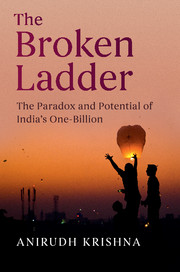Book contents
- The Broken Ladder
- The Broken Ladder
- Copyright page
- Contents
- Figures
- Acknowledgments
- 1 The Dollar Economy and the Rupee Economy
- 2 Beyond-5-km Villages: Where the Lights Aren't Shining Brightly
- 3 Up and Down in the City
- 4 Preventing Future Poverty
- 5 A Deep Pool of Talent
- 6 Attitudes, Experiences, and Information
- 7 Democracy at the Doorstep
- 8 Looking Ahead: Growing the Economy – and Developing Individuals
- Notes
- Bibliography
- Index
- References
Bibliography
Published online by Cambridge University Press: 30 August 2017
- The Broken Ladder
- The Broken Ladder
- Copyright page
- Contents
- Figures
- Acknowledgments
- 1 The Dollar Economy and the Rupee Economy
- 2 Beyond-5-km Villages: Where the Lights Aren't Shining Brightly
- 3 Up and Down in the City
- 4 Preventing Future Poverty
- 5 A Deep Pool of Talent
- 6 Attitudes, Experiences, and Information
- 7 Democracy at the Doorstep
- 8 Looking Ahead: Growing the Economy – and Developing Individuals
- Notes
- Bibliography
- Index
- References
Information
- Type
- Chapter
- Information
- The Broken LadderThe Paradox and Potential of India's One-Billion, pp. 248 - 297Publisher: Cambridge University PressPrint publication year: 2017
